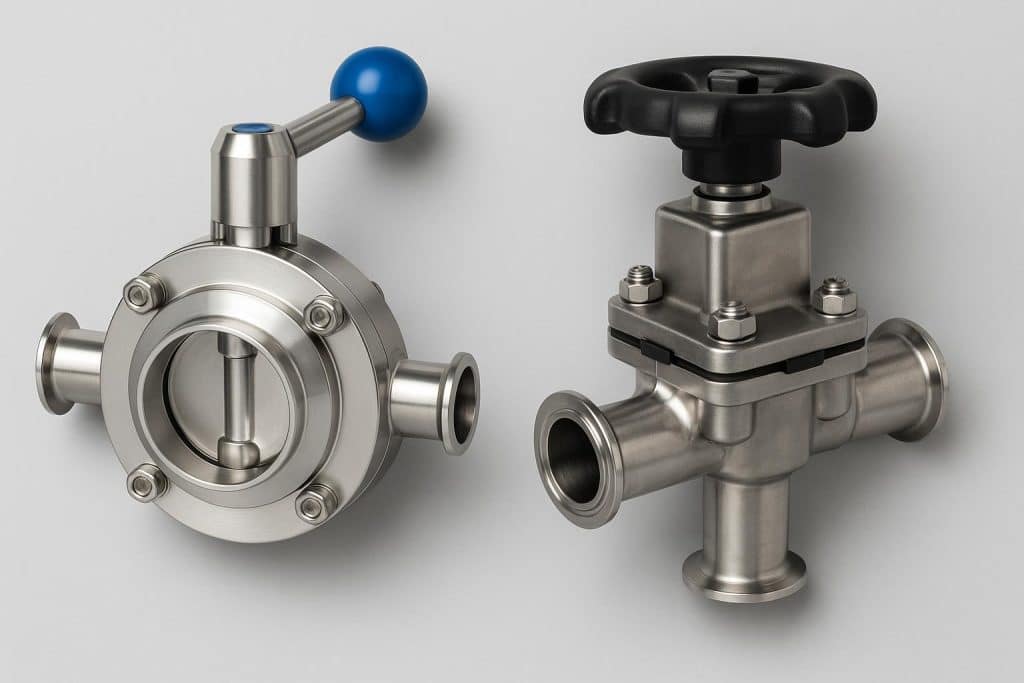In industries with extremely high hygiene requirements such as food, beverage, and pharmaceuticals, the choice of valves directly affects product quality and production safety. Sanitary butterfly valves and sanitary diaphragm valves are two common types of sanitary-grade valves, but they differ significantly in their structural principles and applicable scenarios.
Different Structures and Working Principles
The butterfly valve mainly consists of a valve body, a disc (butterfly plate), a valve stem, and a sealing ring. It has a simple structure and controls the flow of medium by rotating the disc. When the disc is parallel to the pipeline, the valve is open; when it is perpendicular, the valve is closed. This structure is simple and compact, with low pressure loss, making it suitable for high-flow applications.
The diaphragm valve consists of a valve body, a diaphragm, and a valve cover. The diaphragm is typically made of elastic materials such as EPDM or PTFE. Sanitary diaphragm valves operate on a completely different principle from butterfly valves. They use the up-and-down movement of an elastic diaphragm to open or close the flow channel. The diaphragm, as a key component, completely isolates the valve cavity from the actuator, ensuring that the medium only comes into contact with the diaphragm. This design achieves a truly dead-leg-free structure, eliminating the risk of contamination.
Different Applicable Scenarios and Medium Characteristics
Sanitary butterfly valves are suitable for low-viscosity media without particulate matter and are commonly used in conveying pipelines and CIP (Cleaning-in-Place) systems in industries such as beer and beverages. However, the gap between the disc and the valve seat may create sanitary dead ends, making them unsuitable for handling high-viscosity or particulate-laden media.
Sanitary diaphragm valves are particularly suitable for applications with high hygiene requirements, such as sterile processes in the pharmaceutical industry and biological fermentation. Their dead-leg-free structure can effectively handle fluids containing particles or fibers and can even be used for some corrosive media, ensuring complete isolation and zero contamination.
Different Sealing Performance and Cleaning Methods
Sanitary butterfly valves rely on the elastic deformation of the sealing ring for sealing. Their sealing performance depends on the quality of the sealing material and the machining precision of the disc. During cleaning, special attention must be paid to the edges of the disc and the sealing ring, as there may be hard-to-clean areas.
Sanitary diaphragm valves offer excellent sealing performance. The seal between the diaphragm and the valve body is surface contact, providing better sealing. Their smooth flow path design and dead-leg-free structure allow for more thorough cleaning and more reliable sterilization processes. However, the diaphragm requires regular replacement.
Different Service Life and Maintenance Costs
Sanitary butterfly valves have a simple structure, a long service life, and relatively low maintenance costs. Under suitable conditions, the main maintenance task is regularly replacing the sealing ring, making overall maintenance relatively straightforward.
Although sanitary diaphragm valves have a higher initial investment, their performance advantages in special conditions are significant. The diaphragm, as a wear-prone part, requires regular replacement, which increases long-term maintenance costs. However, in high-hygiene applications, this investment is necessary and worthwhile.
Conclusion
Choosing between a sanitary butterfly valve and a diaphragm valve requires comprehensive consideration of process requirements, medium characteristics, and hygiene standards. Butterfly valves are suitable for general sanitary applications with high flow rates and low-pressure differences, while diaphragm valves are ideal for high-hygiene requirements and special media handling. In practical applications, it is advisable to select the most suitable valve type based on specific process characteristics and cost budgets to ensure hygienic safety and operational efficiency in the production process.
